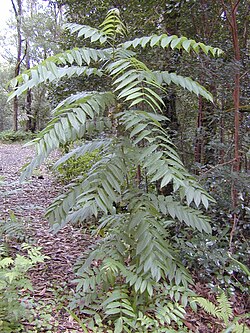Toona ciliata
| Habit | tree
| |
|---|---|---|
| Height: | ⇕ | 120 ft"ft" can not be assigned to a declared number type with value 120. |
| Width: | ⇔ | 20 ft"ft" can not be assigned to a declared number type with value 20. |
| Lifespan: | ⌛ | perennial |
| Bloom: | ❀ | early spring, mid spring, late spring |
| Exposure: | ☼ | sun |
|---|---|---|
| Features: | ✓ | deciduous, flowers |
| USDA Zones: | 9 to 12 | |
| Flower features: | ❀ | red, pink, white |
|
Toona > |
ciliata > |
Australian Red Cedar (called also Toon, Suren or Indian Mahogany), Toona ciliata [1] is a forest tree in the family Meliaceae which grows throughout southern Asia from Afganistan to Papua New Guinea and Australia.[2] In Australia its natural habitat is now extensively cleared subtropical rainforests of New South Wales and Queensland. The Australian population was formerly treated as distinct species under the name T. australis. The species can grow to around 60m in height and its trunk can reach 3m in girth. The largest recorded T. ciliata tree in Australia grew near Nulla Nulla Creek, west of Kempsey, New South Wales and was felled in 1883[3].
The southern most limit of natural distribution is on basaltic soils, growing west of the Princes Highway near the village of Turmeil, south of Ulladulla, southern Illawarra, NSW.[4] It also naturally occurs at Norfolk Island.
It is one of Australia's few native deciduous trees. The timber is red in colour, easy to work and very highly valued. It was used extensively for furniture, wood panelling and construction, including shipbuilding, and was referred to as "Red Gold" by Australian settlers[5]. Heavily and unsustainably exploited in the 19th Century and early 20th Century, almost all the large trees have been cut out and the species is essentially commercially extinct.[6] However, the timber is relatively fast growing and following on from a wave of tree cutting in the 1950s, regrowth and timber from forestry sources currently provides trees up to 1 metre in diameter for the furniture trade in Australia and timber is not difficult to source.Template:Fact
The Red cedar is widely planted in subtropical and tropical parts of the world as a shade tree and for its fast-growing aspect. It is grown in the Hawaiian Islands and southern and eastern Africa. In parts of Zimbabwe and South Africa, it has naturalised; growing to maturity and spreading from seed.[7]
Cultivation
Propagation
Pests and diseases
Varieties
Gallery
Giant Red Cedar, Lamington National Park, Qld
Red Cedar, Mount Keira, Illawarra, NSW
Healthy Red Cedars in July, Barrington Tops, NSW
Australian Red Cedar - New Growth in September, Allyn River, Barrington Tops, Australia
Toona ciliata - red leaves in September, Mount Keira, Illawarra, NSW
a stand of Toona ciliata near Kempsey, New South Wales
40 metre Toona ciliata, leafless in August, with epiphytic Dendrobium orchids at Barrington Tops, Australia
References
- ↑ http://plantnet.rbgsyd.nsw.gov.au/cgi-bin/NSWfl.pl?page=nswfl&showsyn=&dist=&constat=&lvl=sp&name=Toona~ciliata
- ↑ http://www.ars-grin.gov/cgi-bin/npgs/html/taxon.pl?36753
- ↑ http://www.colongwilderness.org.au/RedIndex/NSW/newen99.htm
- ↑ Eurobodalla Regional Botanic Gardens
- ↑ http://www.time4timber.com.au/types-of-timber.html
- ↑ Vader, John. (1987). Red Cedar. The Tree of Australia’s History. Reed: Sydney. ISBN 0-7301-0151-7
- ↑ http://www.zimbabweflora.co.zw
External links
- w:Toona ciliata. Some of the material on this page may be from Wikipedia, under the Creative Commons license.
- Toona ciliata QR Code (Size 50, 100, 200, 500)












